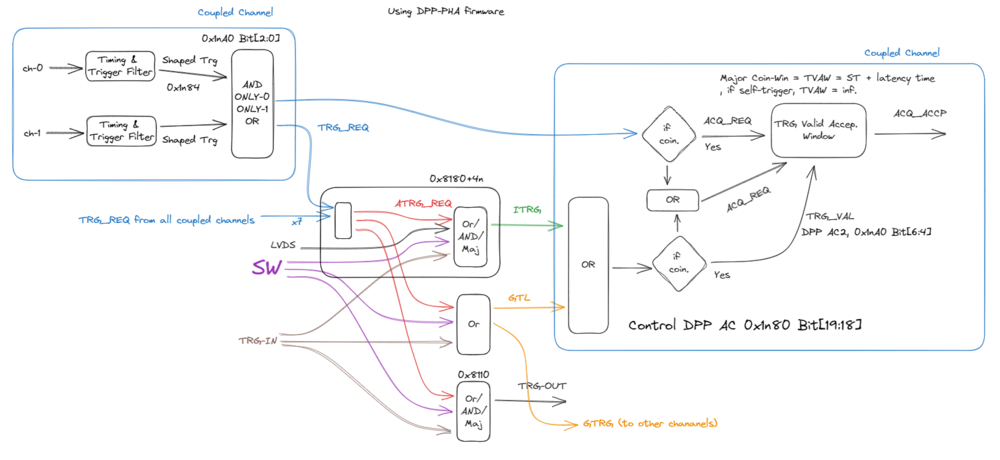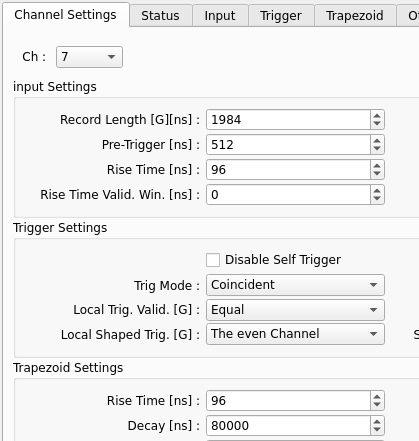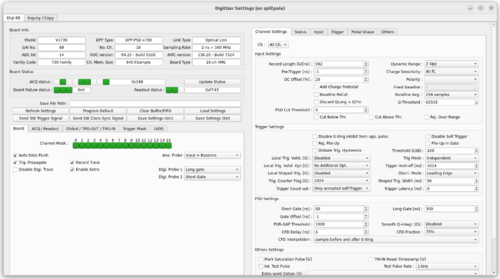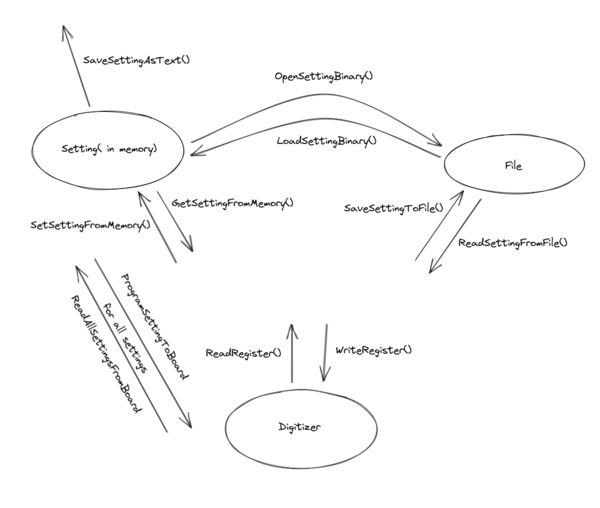CAEN digitizer
Model
| Model | Energy resolution | Sampling rate |
|---|---|---|
| V1725 | 14-bit | 250MS/s |
| V1730 | 14-bit | 500MS/s |
| V1740 | 12-bit | 62.5 MS/s |
DPP firmware
Both V1725 and V1730 can be equipped with the PHA (pulse-height analysis) or PSD (pulse-shape decimation) firmware.
From the programming point of view, the channel registers ( < 0x1XXX ) are very different for the two firmware, but the board registers (0x8000 to 0xFFFF) are almost identical.
required library
On Linux (Ubuntu 18.04+), two CAEN libraries are required to run the digitizers.
- CAENVMELib
- CAENComm
that would be enough for running the CAEN CoMPASS.
For custom programs, an additional library is needed
- CAENDigitizer
PLL (Phase-Locked-Loop) firmware
A digitizer need a proper PLL firmware to run.
If the PLL firmware is wrong (i.e. The PLL lock led is off ), you need to refresh the PLL firmware using the CAENUpgrader
The PLL file has the format of
V17XX_vcxo500_refYY_pll_outZZ.rbf
where
XX is the model type,
for example 25, 25S, 30, 40
YY is the ref clock,
for the master or stand alone digitizer, 50 (= 50 MHz ) is ok. for a slave, it must be 62_5.
ZZ is the clock output,
for master or stand alone digitizer, 0 or 62_5 (= 62.5) are OK. for a master that connect to a slave, it must be 62_5. for a slave, that connect to an other slave, it must be 62_5
Synchronization of multiple digitizers
This is important when multiple digitizers are used. A digitizer using its internal clock (controlled by a switch on the board) is a designated Master. Synchronization means:
- Same source of clock
- Same phase (or constant difference in phase, it can be corrected by the Run delay (0x8170))
- Same starting time for ACQ
Notice that a Timer Reset can be done by writing the Software Clear register (0xEF28), but it does not guarantee all timers are clear at the same time. The Software clear is done whenever ACQ starts.
Master and Slaves Method
The CLK-out of the Master connects to the CLK-in of the slave in the daisy chain. And all slaves should use an external clock. The PLL firmware must be changed properly in order for the clocks of the master and the slaves to be locked and sync.
External Clock unit, everyone is slave Method
testing clocks
The TRG-OUT can be set with register 0x811C to be CLKOUT or CLK Phase. so that the synchronization can be checked.
TRG-IN/TRG-OUT daisy chain
Connect the TRG-IN (Master) to TRG-OUT (Slave). All slaves are set the ACQ start/stop on the TRG-IN (0x8100:[1:0]). The Master is set the ACQ star/stop to SW trigger, and the TRI-OUT is RUN (0x811C::[19:16]).
Once the master ACQ is started by SW, its TRG-OUT will send RUN signal and propagate to the slave TRG-IN that the slaves will be start/stop accordingly.
using S-IN with external TTL/NIM pulse
All master and slaves are set the ACQ start/stop to be S-IN, and TRG-OUT are S-IN (copy of S-IN). Master and slaves are connected TRG-OUT/S-IN daisy chain.
An external gate generator is needed to send an ACQ start signal to the master S-IN to start the data acquisition.
Triggering
Below is the Trigger Logic, the register is for DPP-PHA firmware.
Channel or Coupled Channel
| PHA | PSD | QDC | Bit | Description |
|---|---|---|---|---|
| 0x1n80 | 0x1n80 | 0x1n40 | 19:18 | DPP Algorithm Control, Trigger Mode. |
| 24 | DPP Algorithm Control, Disable self trigger | |||
| 0x1n84 | 0x1n70 | 0x1n78 | PHA/PSD : Shaped Trigger Width QDC : Trigger Out Width | |
| 0x1nA0 | 0x1084 | N/A | 2:0 | DPP Algorithm Control 2, Local Shaped Trigger Mode |
| 6:4 | DPP Algorithm Control 2, Local Trigger Validation Mode | |||
| 15:14 | DPP Algorithm Control 2, Source of veto | |||
| 0x1nDA | 0x1nD4 | N/A | Veto Width | |
| 0x8180 + 4n | 0x810 + 4n | N/A | Trigger Validation Mask | |
| N/A | 0x106C | N/A | Trigger Latency |
Board
| Register | ! Bit | Description |
|---|---|---|
| 0x810C | Global Trigger Mask or Logic | |
| 0x8110 | Front Panel TRG-OUT Logic | |
| 0x811C | 10 | TRG-IN control |
| 11 | TRG-IN to Mezzanines (Channel FPGA) |
Single board
Scenario 0
No coincident, or self trigger.
0x1n80 0x00000 0xC0000 // set Trigger mode to Normal mode or Independent mode at DPP Algorithm Control.
Scenario 1
Ch-1 is triggered from Ch-0, no matter there si signal for Ch-0
0x1080 0x40000 0xC0000 // Ch-0 to be Coincident 0x10A0 0x70 0xF0 // The local Trigger validation is OR. i.e. from any channel. 0x10A0 0x5 0xF // The local Shaped Trigger for Coupled channel-0 is from the even channel (i.e. ch-0)
Scenario 2
Coincident of ch-0 and ch-1 when both channels are within 1000 ns or 125 ticks.
Register Setting for DPP-PHA is:
0x1084 0x7D // set the shaped trigger width is 1000 ns for channel 0 0x1184 0x7D // set the shaped trigger width is 1000 ns for channel 1 0x1080 0x40000 0xC0000 // set channel-0 to be coindient mode 0x1180 0x40000 0xC0000 // set channel-0 to be coindient mode 0x10A0 0x00 0x7 // Enable local Shaped Trigger, AND mode
Scenario 3
when ch-0 is fired and triggered, if ch-7 is also fired, record both ch-0 and ch-7. When ch-0 is fired and triggered, but if ch-7 has nothing, don't need to record ch-7 but only ch-0.
Register Setting for DPP-PHA in the free writefile:
//boardID address value mask 0-14-177 0x10A0 0x5 0x7 //DPP Algorithm Control 2 for channel-0, bit[2:0] = 101. Enable local Shaped Trigger, Mode is even channel of the coupled channel ONLY. 0-14-177 0x1780 0x40000 0xC0000 //DPP Algorithm Control for channel-7, bit[19:18] = 01. Trigger mode = Coincidence Mode 0-14-177 0x1784 0xFF 0x3FF //Shaped Trigger Width for channel-7, bit[9:0] = 00 1111 1111. Generate Shaped trigger of 255 * 16 ns. 0-14-177 0x16A0 0x50 0x70 //DPP Algorithm Control 2 for channel-6, bit[6:4] = 101. Enable local Trigger Validation, Mode is val0 = val1 = signal from mother board mask. 0-14-177 0x818C 0x1 0xFF //Trigger Validation Mask for the 3rd (4*3 = C) coupled channels (ch-6-7). bit[7:0] = 0000 0001. Set trigger of coupled channel 3 from coupled channel 0.
In FSUDAQ, in the Digitizer Settings Panel,
- Set the ch-0, Local Shaped trig. [G] to be The even Channel
- Set the ch-7, Trig Mode to be Coincident, Local Trig. Valid. [G] to be Equal
- In the board setting, go to the Trigger Mask tap, and set row 6-7, column 0-1.
Notice that the ch-6 will be triggred. To avoid this, can disable ch-6, or set ch-6 Trig. Mode to be Coincident.
Multiple boards
Reading the bin file from CAEN CoMPASS
The CoMPASS can output *.bin data. The beginning of the file is a 2 bytes header. It must be in the form of 0xCAEx, where x indicate the energy format and waveform existence. After that,
| block | bytes |
|---|---|
| Board | 2 |
| Channel | 2 |
| Timestamp | 8 |
| Energy | [x == 1, 2], [x == 2, 8], [x == 3, 10], [x == 4, 2] |
| Flags | 4 |
| Waveform code | 1 |
| number of samples | 4 |
| trace ... | 2 * (number of samples) |
If x < 8, there is no waveform.
A BinReader class can be found in here.
Data structure, Read-out, and buffer size
In the CAENDigitizer.h, the CAEN_DGTZ_READDATA() will read the buffer of the digitizer. For a single call of the function, ONE aggregate of data is read from the buffer and clear.
The number of events for an aggregate is set by register 0x1034. When set to zero, the digitizer (mysteriously) auto-set.
The data structure started with 4 words ( 1 word = 32 bits).
FSUDAQ
https://fsunuc.physics.fsu.edu/git/rtang/FSUDAQ
The (idea of the) FSU DAQ is based on the BoxScore(code of BoxScore). The core is the digitizer class that directly controls and reads out the CAEN digitizer. The GUI of the DAQ uses CERN ROOT GUI elements.
The Goals for the DAQ are:
- support V1725, V1730, V1740 digitizers
- multi-thread readout and real-time time sorting (possibly events building)
- extendable to other digitizers and functionalities
- user-friendly (full GUI, limited terminal output)
- easy to maintain (avoid abstract coding and entirely objective programming)
- for Ubuntu 22.04 or equivalent
- binary output or root tree output
The development of this version is stopped at the end of 2022. The main reason is that it crashes when the mouse action on a histogram when ACQ is running. It is the problem of the CERN Root Drawing algorithm.
FSUDAQ (using Qt6)
The FSUDAQ GUI uses CERN ROOT Qt, which is based on Qt4. A new GUI is being made using Qt6. The FSUDAQ(Qt6) is very similar to the SOLARIS DAQ.
https://fsunuc.physics.fsu.edu/git/rtang/FSUDAQ_Qt6
In this development, the histogram (1D or 2D) will be developed based on QChart, which interaction with QChart during ACQ running is crash-free.
The Digitizer Class
The Digitizer class is ClassDigitizer.h/C. The class controls the digitizer by manipulating the register. And various types of digitizers are different by the registers. Thus, the class can control different types of digitizers without modification. The digitizer classes store the connection, board information, and a copy of the register. It provides an interface to better control the digitizer, for example, manipulate the bits for the control bit.
The digitizer classes directly write/read the registers in the digitizer. The advantage is complete control of the hardware and a simplified program that only 3 pieces are needed:
- WriteRegister()
- ReadRegister()
- Table of Register Address
- Load (Save) register setting from (to) a binary file
The drawback is that the buffer size must be calculated (a lazy man method is assigned 100 MB for the buffer?).
Register Address and Setting Binary File
The registers < 0x8000 are channel settings. For example, 0x1nXX is for channel-n, or 0x80XX is for writing to all channels. The registers >= 0x8000 are board settings.
For all types of digitizers, the register > 0x8000 registers are the same and have the same meaning.
Because the 2n and 2n+1 channels are paired ( like shared same memory ). There are some registers also paired. for example, the record length is the same for any paired channels, once the record length is set for any one of the paired channels, the record length of the other channel is also set.
A Setting uses 4 bytes (unsigned int) to store 32 bits of each register value. Using an array of size 2048 can store all register settings, which is only 8192 bytes. The following table shows the conversion.
| Address Range | Comment | Setting Index | Example |
|---|---|---|---|
| 0x1000 - 0x1FFF | Channel Setting | 0x1XXX / 4 | 0x1020 -> 1032 |
| 0x8000 - 0x81FF | Board Setting | 0x8XXX & 0x0FFF | 0x8080 -> 32 |
| 0xEF00 - 0xEFFF | Other Board Setting | 0xEXXX & 0x0FFF | 0xEF04 -> 961 |
| 0xF000 - 0xFFFF | Read only board configuration | (0xFXXX & 0x0FFF) + 0x0200 | 0xF008 -> 520 |
The digitizer class provides a method to convert the setting binary to a text file. The following diagram illustrates the methods between board setting, setting in memory, and setting file
Buffer Size calculation
The data stored in the digitizer can be retrieved using
CAEN_DGTZ_ReadData(int handle, CAEN_DGTZ_ReadMode_t mode, char *buffer, uint32_t *bufferSize);
typedef enum {
CAEN_DGTZ_SLAVE_TERMINATED_READOUT_MBLT = 0,
CAEN_DGTZ_SLAVE_TERMINATED_READOUT_2eVME = 1,
CAEN_DGTZ_SLAVE_TERMINATED_READOUT_2eSST = 2,
CAEN_DGTZ_POLLING_MBLT = 3,
CAEN_DGTZ_POLLING_2eVME = 4,
CAEN_DGTZ_POLLING_2eSST = 5,
} CAEN_DGTZ_ReadMode_t;
The data format of the buffer contains two parts: A whole chuck of the buffer can contain multiple board aggregation (depending on the value of 0xEF1C). Inside a board aggregation, there could be at most 8 Dual Channels Aggregation, depending on the channel mask. Each Dual Channels Aggregation can contain at most 511 measurements (set by 0x1n34). See the block diagrams on the
Each Board Aggregation has 4 words of header. 1 words = 4 bytes = 32 bits. Each Dual channel Aggregation has 2 words of header. after that is Ne events (0x1n34) for paired channels. In each measurement, there is 1 word of header, Sample/2 words for waveform, 1 word for Extra2 (if any), and 1 word for Energy, so total = (2 + Sample/2 + Extra), where Sample size is the Record Length = (0x1n20) * 8 ch. Extra is controlled by bit[17] of (0x8000), denote as (0x8000:17)
There is a maximum of 8 Dual Channel aggregations for 1 Board Aggregation for 16-channel digitizer. Thus, for 1 Board Aggregation, the max number of words is 4 + 8 * (n * (2 + Sample/2 + Extra)).
In Each readout, there can be more than 1 Board Aggregation (0xEF1C). The total buffer size (byte) needed is
where bit value of 0xEF1C
bit value of 0x1n34, n = paired channel ID
Channel enabled mask of the paired channel n.
bit value of 0x1n20
bit value of 0x8000, bit-17
However, this calculation is about factor 2 smaller than the CAEN's calculation in
CAEN_DGTZ_MallocReadoutBuffer(int handle, char **buffer, uint32_t *size);
The CAEN's formula for the buffer size is almost 2 times more.
Readout
The Event per Aggregation (0x1n34) are shared by the paired channels. for example, for 10 Event per Aggregation, the dual channel aggregation will only store 10 events for both paired channels.
The Maximum trigger for each dual channel is (Event per Aggregation) * (Aggregation per readout)
Also, it seems that, the maximum events in all paired channel is set by the maximum event number of the highest trigger rate channel. For example, I have 27 Hz input for channel 0,1, and 15. Although the Event per Aggregation was set to 60. the number event in the 0-1 dual channel aggregation is 27, which is the same number as the 14-15 dual channel.
Contact
Tsz Leung (Ryan) Tang mailto:rtang@fsu.edu















